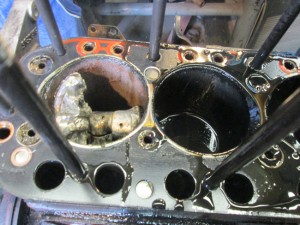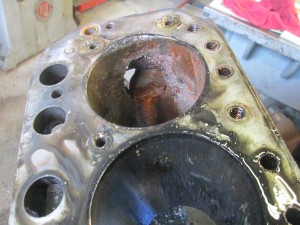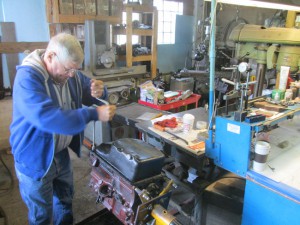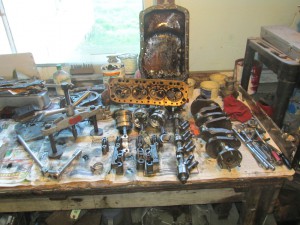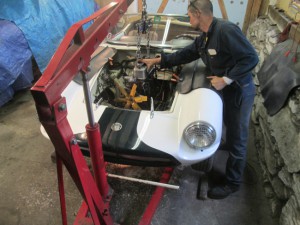Regrettably, the green liquid bubbling out of the Elva’s engine dipstick tube last week wasn’t Duckham’s QXR 20W50, it was coolant.
When we pulled the cylinder head, #1 piston was well and truly shattered. Also, a tinkling sound could be heard from below as we flipped the engine upside down because the oil pan was full of debris.
Click to enlarge this picture. There’s a new high volume coolant drain-back hole just behind the water pump outlet at the front of the block. Less obvious is the cylinder liner sleeve which you can just discern because it’s started to pull out of the bore. You can see it as a curved line across the 15 degree exhaust valve relief at the very top of the cylinder. Less obvious, but very much there, is a crack across the right side of the bore, and below it is another, much smaller, irregularly shaped hole.
Judging by the engine bearings, which were almost brand new, there wasn’t a great deal of time on this engine.
Patrick believes the cylinder liner calved, but in my mind the chain of events began with an on-going failure of the cheezy aluminum valve spring retainers which allowed the #1 exhaust valve to float long enough to collide with the on-rushing piston, bending the con-rod and putting the wrist pin thru the cylinder wall. Under my scenario, the cylinder liner succumbed to thermal shock. Whether it was a primary or secondary cause, the head of the valve, barely recognizable, ended up in the oil pan.
As Oliver Hardy once said, “This is another fine mess you’ve gotten us into”. There’s a mound of shrapnel in the bottom of the oil pan, and the mostly unrecognizable remains of #1 exhaust valve are sitting on top of #1 spark plug, but I put it there after I fished it out of the pan. The rod bearings are still shiny, so are the skirts of the pistons.
Some other points of interest are the pistons themselves which have an additional oil control ring around the skirt. This, to be polite about it, is an anachronism. As most readers of these missives are well aware, the ‘Brits had horrible problems with oil control, and an MG TD or early Jag XKE which only used a quart of oil every 500 miles was an exemplery performer.
In consequence, one common fix was the “split skirt” piston which could be clearanced tighter in the bore, the hot piston skirt expanding into the slit. An additional oil ring was another fix. None of it was worth Jack’s Shirt, it was all a result of poor cylinder wall finish, which the lowest man on our totem pole fixes with a Flex-Hone tool these days.
On the few occasions when we have to use these Neanderthal design pistons we throw the bottom oil ring away because we don’t need the increased friction, or the possible cylinder wall oil starvation, and that might in fact be the key to the puzzle.
We’re gonna try to talk Mike into a 5-main MGB bottom end with a large overbore and a cross-flow aluminum head, properly balanced, which this one wasn’t. So, we shall see what we shall see.

